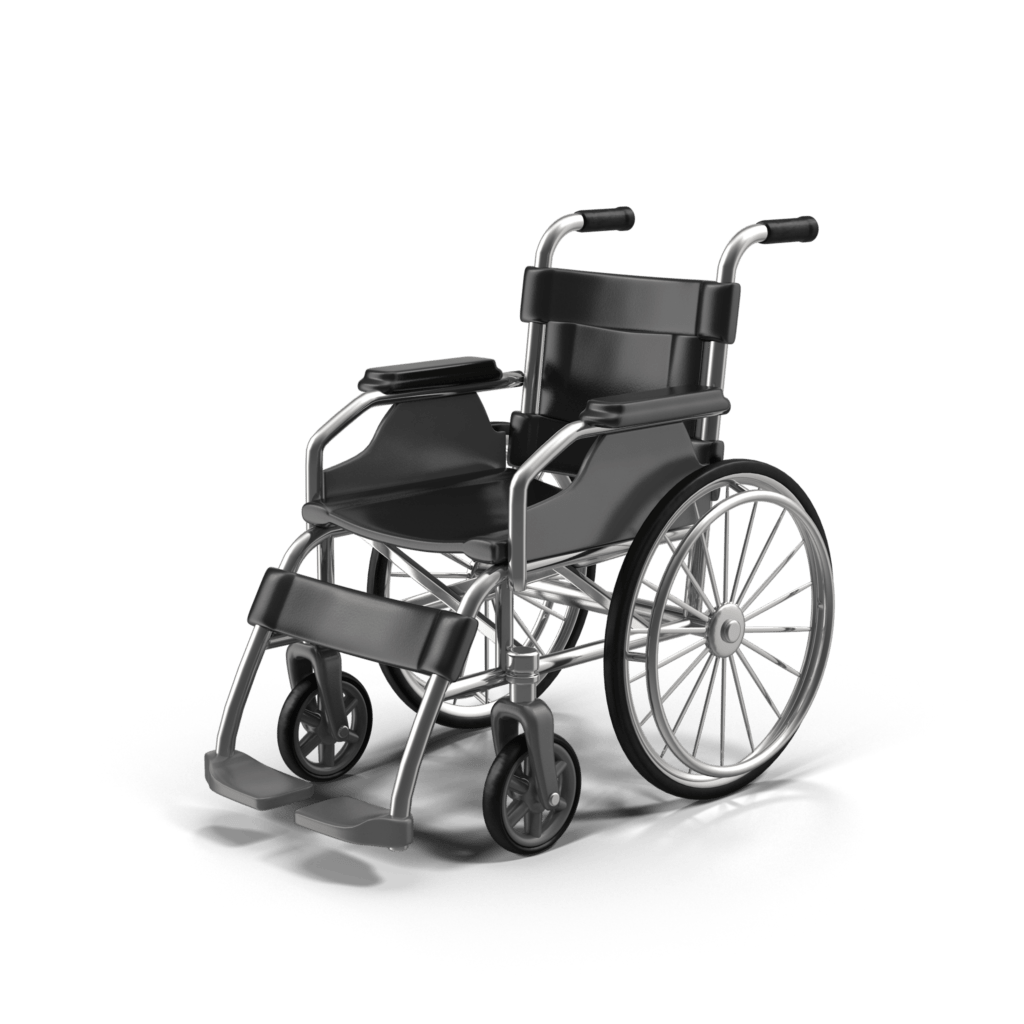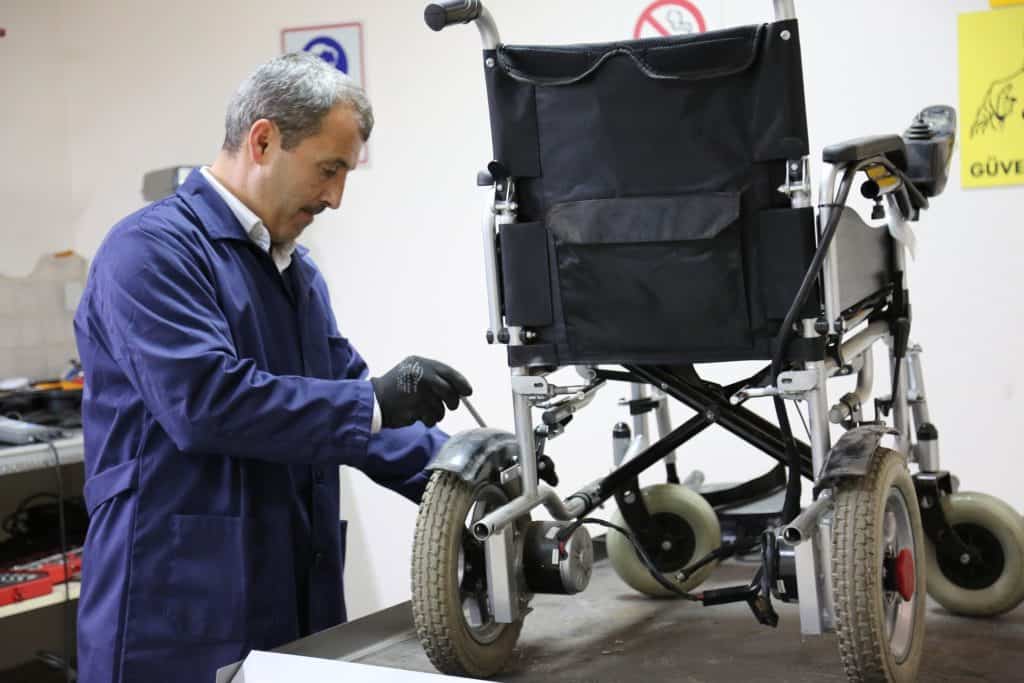
Looking for a new wheelchair can be a grueling process. With so many options out there to choose from, it can be hard to determine which one is the best and will last the longest. On this journey, it is essential to know what factors go into determining how long manual wheelchairs last.
How long do manual wheelchairs last? The average manual wheelchair has a lifespan of four years. When determining the lifespan of a wheelchair, there are many factors to consider that can affect the length a manual wheelchair will last, such as:
- Materials
- Frame failure
- Rear wheel placement
- How wheelchairs commonly break
- Cost
- Commonly broken parts
- Maintenance
- Studies done to assess lifespan
- Servicing
- Weight
In order to purchase the longest lasting wheelchair, you will need to understand what determines the lifespan of a wheelchair. This will help you avoid the frequent purchasing of new wheelchairs because it quickly becomes unusable.
Understanding the Lifespan of a Manual Wheelchair
The length of time a manual wheelchair is usable will greatly depend on its quality and how it is maintained. Let’s walk through what to look for in each category to find a long-lasting manual wheelchair.
Materials
Aluminum and steel are typically the metals that product creators use when designing a wheelchair.
Aluminum
Aluminum can reduce the weight of the wheelchair since it is lighter than steel. The problem with aluminum is that it is weaker than steel. The wheelchair will crack and get brittle, so their duration is shorter than other materials. This material provides a more lightweight and cheaper wheelchair. Aluminum wheelchairs usually last an average of two years.
Steel
Steel is stronger than aluminum, so wheelchairs made out of this material will last longer than those made of aluminum. High-quality steel wheelchairs are heavier and are more difficult to guide. Lower priced ones tend to be made from low-grade steel. Wheelchairs made from steel will last an average of three to four years.
Titanium
Titanium is ideal for many people when deciding on what material of the wheelchair is best to purchase. Unlike aluminum chairs, titanium doesn’t cause the product to bend or crack because it is more flexible. This material incorporates the benefits of using aluminum with the benefits of using steel. They are lightweight, like aluminum and strong like steel.
Carbon Composite
Carbon composite wheelchairs are the strongest, but they are also more expensive. This material is strong and creates a lightweight chair like titanium does. The problem with carbon composite is that it is more expensive, and these chairs are harder to customize.
Frame Failure
Frame failure can force wheelchair users to buy a brand new frame. Knowing how common frame failures occur can allow you to preserve the life of your wheelchair.
Folding wheelchairs have a cross-brace. A lot of wheelchairs have two cross-braces that connect with a bolt in the middle. This creates an “X” cross-brace. The brace can form fatigue cracks near the bolts hole. If this happens, the brace will fail and impair the usage of the wheelchair.
Cracks may also form on the welds that connect the cross-brace to the horizontal seat tubes. When cracks form in this area, the wheelchair becomes inoperable.
A wheelchair can also fail where welds and bolts connect the frame and the casters. The bolts that connect the two can often crack since it is an area of high stress. High amounts of stress are placed on the frame because of the forces and pressure being put on the casters.
These forces then impact the connecting bolts and can cause the frame to fail. Similarly, if the welds fail, a new frame must be purchased.
The tubing that holds the backrest also connects to the tubing that holds the seat. Filler material joins these two things. This is done through the process of welding or brazing. With forward movement, the force that is exerted onto the backrest will be directly transmitted to the joint that connects the two.
When the wheelchair is propelled, the backrest will be impacted because of the user rocking back and forth against it. A new frame will be needed because of the repetitive rocking causing high amounts of stress around the weld, leading it to its breakage.
Rear Wheel Placement
When the rear wheels are not in the correct position, the propulsion mechanics of the wheelchair are directly affected. An increase will happen of the amount of force and stroke required to propel the product. When those rates increase, the risk of upper extremity dysfunction, strains, and pain will also increase.
If the rear wheel is more forward than it should be, the shoulder can experience:
- Less internal rotation
- An increase in push angles
- A decrease in the frequency of propulsion
- Decreased rolling resistance
- Increased push rim access
- A decrease in the force required
- An increase in the efficiency
Purchasing an ultra lightweight manual wheelchair can help reduce some problems as well. This design has an adjustable axle that can allow users to fix the height of the chair’s rear seat.
Adjusting the height will cause the height of the rear seat to be low enough to fully access the wheel while still being high enough to avoid harmful shoulder angles. This can increase the push angle, contact time, and can also increase the user’s access to the wheel’s rim.
These two things can decrease the levels of required repetitive motion. Repetitive motion can avoid injuring the user from strains and can also prevent wheelchair purchasers from purchasing a power wheelchair when they are dissatisfied with a manual one. These wheelchairs are more expensive than manual ones.

How Wheelchairs Commonly Break
Being aware of how wheelchairs commonly break can prevent you from breaking your manual wheelchair. Avoiding these common mistakes can help you keep your wheelchair in great condition for a long duration of time. Some things that can cause a wheelchair to break are:
- The type of surface that the wheelchair was used on- using the wheelchair on smooth concrete can increase the lifespan of a wheelchair; however, using the wheelchair on either a lawn or on earthy areas, the longevity of the chair decreases. Using the product on rough or uneven surfaces can cause accidents and damage.
- Distance- the greater the distance the wheelchair is used per day, the more likely a wheelchair is at risk for damage. Going a distance of over fifty meters per day can cause a greater potential for breakage.
- Lifestyle- as indicated in the first bullet point, using the wheelchair on earthy surfaces can decrease the lifespan of a manual wheelchair. Very active people will put more stress on their chair than someone who stays indoors a lot. High stress can also be put on the chair when going over curbs and other obstacles.
- Weights Considerations – The heavier a person is, obviously the higher the amounts of pressure the chair is subjected to. It is important to know the weight limit and overall size of the chair when purchasing a manual wheelchair.
- Accidents- It is important for you to carefully handle your wheelchair when moving it in and out of a car. If you drop the chair or bang it against something, you can risk breaking it. How carefully you handle your wheelchair will determine if the chair will have a longer lifespan or not. It is essential not to leave your wheelchair unattended. Some people may steal wheelchair parts, so vigilance must be maintained when the chair is not in use.
Commonly Broken Parts
Certain wheelchair parts are more essential than others. It may not be a big deal when certain parts break, but the breakage of other parts can directly affect the ability to use and navigate the product. Knowing the parts that can break will allow you to access the quality of a wheelchair’s pieces. This will allow you to get a better estimate on how long the product will last.
In a study conducted by the Research and Technology Affairs Division at Khon Kaen University, researchers were able to determine which parts commonly broke on manual wheelchairs. The study analyzed many broken wheelchairs and determined the following about the analyzed wheelchairs:
- 16.1% had broken front-wheel bearings
- 14.6% had broken brakes
- Arm rests were broken on 9.6% of them
- The seat was broken on 9.2% of the wheelchairs
- 11.4% of the footrests had broken
- Tires were broken on 13.4%
- 8.1% had broken metal frames
- The backrest was broken on 5.6% of the wheelchairs
- 3.8% of front wheels were broken
- 3.1% had broken rear wheels
- 1.3% had broken rear-wheel bearings
Even though a lot of these parts were broken, a lot of the participants didn’t have the money to purchase a new wheelchair. They didn’t receive support for a new wheelchair either. Because of this, these users continued to use their broken wheelchairs when doing so puts them at a high risk for injury.
Cost
The price of a manual wheelchair can determine the overall quality of the device. Cost can vary based on the materials both the frame and product are made of.

If a manual wheelchair has a low price, the quality isn’t as great as more expensive chairs. When the quality of the chair suffers, the lifespan of the wheelchair will be directly impacted. Lower priced chairs tend to be heavier than more expensive ones. They also don’t last as long.
Whether it’s the individual in the chair or someone they know is pushing them around, heavier wheelchairs can also risk injury to the person maneuvering the chair around.
A medium priced wheelchair tends to be a higher quality than low priced wheelchairs. Chairs with this level of pricing are usually a lighter weight as well. They also may have more features than cheaper wheelchairs. If you don’t want to pay a lot of money for a high end wheelchair, but you want one that will last a while, you should consider investing in a wheelchair that has a price point in the middle.
Higher priced wheelchairs have the highest quality. If you can save up the money to purchase a chair on the more expensive side, they will last you a long time. You won’t have to worry about repairs as much.
You also wouldn’t have to purchase multiple wheelchairs over your lifetime. These chairs are very lightweight, are made of great frame material, and have some awesome features as well.
Many insurance companies will expect wheelchairs to last five years; however, they usually will only cover depot-level wheelchairs. These wheelchairs are cheap and don’t last as long. Depot-level chairs are wheelchairs that have minimal adjustments and are used in hospitals or institutions. If insurance companies expect wheelchairs to last for five years, depot-level chairs will not last as long.
Maintenance
Maintaining the condition of your wheelchair is essential in preserving it’s lifespan. Similar to a car, certain parts should be checked to assess the condition of parts. This is done to avoid accidents and serious damage to the wheelchair.
Every month, the moving parts of the wheelchair should be checked. Other pieces that should be checked every month include:
- The brakes
- Tire pressure
- The backrest
In addition, it is important to check the footrest and the upholstery every three to four months as well. Checking these things will help allow you to make your wheelchair last longer.
In order to properly assess the condition of these parts, it is important to ask an authorized person to check the condition of your wheelchair. Annual checks are necessary to spot problems with the parts of your wheelchair. These problems will be found early before their condition becomes worse or you are put in a dangerous situation.
Studies Done to Assess Lifespan
To answer the question of how long manual wheelchairs last, we must analyze the patterns of how long chairs have lasted other individuals. In the study I discussed earlier, the researchers were able to determine the average lifespan of wheelchairs through a study.
The study calculated the survival of all of the wheelchairs they analyzed. They determined that 50% of wheelchairs had a four year life expectancy. In addition, 62% of the wheelchairs did not work properly after 4.3 years and 70% of wheelchairs had broken by the five year mark
Servicing
Similar to the last section, servicing your wheelchair will prolong the life of it. It is important to ask your wheelchair provider when your product will need maintenance checks. A wheelchair repair technician can either pick up the wheelchair from your home to fix it, or you can drop it off at their shop.

It is important to determine the risk of the product becoming more damaged if a professional doesn’t move it for you. Choosing the right option when sending your chair to get serviced can avoid the chance of more damage impairing the ability of the technician to fix it. It would also decrease the chances of you having to purchase a new wheelchair.
Removing hair and dust from the casters and front wheels will help the wheels move smoothly. When these things get caught in the wheels, both the mobility and rotation of the wheels are impaired. You should check for caught hair and dust every week.
If your tires are air tires, you should check the air pressure of your wheels before going outside. Certain outdoor conditions can significantly reduce your tire pressure. If the pressure is already low, you would risk your tires becoming flat which would increase the risk of other accidents or damages occurring.
Similar to this, if the tires become torn or worn out, you should replace them immediately. Waiting to fix them can cause the air pressure to decrease as well if there is a tear in them.
Along with accessing the tires frequently, it is also important to check the brakes every month to make sure they are working properly. Broken brakes are an extreme safety hazard and can also cause a wheelchair to fail if a collision occurs completely.
You can seriously injure yourself or somebody else if the brakes aren’t working properly. On top of that, the wheelchair can collide with another object and break completely. This would force you to have to purchase a brand new device.
Lastly, a therapist or seating technician can assess your chair’s cushion to determine if you need a new one or not. Cushions are essential for your comfort when using a wheelchair. Overtime, the condition of this part will compress and become worn out. If this happens, you will be less comfortable and will lack the needed support to use your wheelchair.
Weight
Lightweight or depot-level wheelchairs have no minimum Medicare or body requirements, so manufacturers have no intention to improve the quality or comfort of these wheelchairs. Depot-level chairs weigh 36 pounds or more while lightweight wheelchairs weigh 36 pounds or less. These chairs offer the lowest quality and do not last very long.
Ultra lightweight manual wheelchairs weigh less than 30 pounds. These chairs meet the intense standards of the Rehabilitation Engineering and Assistive Technology Society of North America (RESNA).
Ultra lightweight manual wheelchairs are approved by the RESNA for their stability, dimensions, and expected life. These chairs are made of aerospace grade aluminum which is a more durable material than depot-level or lightweight wheelchairs.
Ultra lightweight chairs are also more durable and cost-effective. The quality is much better than the 36-pound wheelchairs so that these chairs will last a while.
